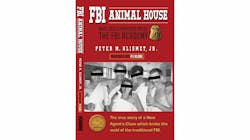Retired FBI Special Agent Peter M. Klismet, Jr. has taken a bold step with the release of his new book, FBI ANIMAL HOUSE. Described as a true story, it’s a critical account of his training while attending new agent class at the FBI Academy in Quantico, Virginia. He pulls no punches in telling his story, which covers the 1980s and 1990s. Klismet contends the training the FBI gave its new agents during that period was subpar, particularly when compared to police departments across the nation.
The author is well-educated (two masters degrees), and is a former Ventura PD sergeant. He left the department after nine years to join the FBI, and served as a profiler during his final years in the Bureau.
Although he acknowledges the training new agents now receive is much better than when he accepted the appointment, he pulls no punches in describing the lackluster training he and his classmates endured. Not only does he say the instruction was lacking, but he also disparages some of the instructors as well.
Subjects such as photography, first aid, and fingerprinting consumed almost two weeks of the 16-week training cycle. He says the classes were a waste of time for the new agents, particularly since the test given for the first aid block didn’t even count as one required to graduate. The fingerprinting block focused more on reading loops, whirls, and arches, rather than taking a person’s fingerprints, lifting prints at crime scenes, and instruction on how to take major case prints. The fingerprint class seemed geared more toward fingerprint examiners than field agents.
The author constantly stressed the Bureau’s attempt to imbue in them a sense of FBI honor and the importance of always exhibiting an exemplary image. A constant theme heard each week was, “Don’t do anything to embarrass the Bureau.” During J. Edgar Hoover’s reign, an innocent indiscretion such as being overweight was grounds for dismissal. Image was everything, and to a large extent, Klismet points out the FBI has survived for years by virtue of the mystique Hoover created about the agency. People are enamored of the FBI image, which Klismet says is largely mythical.
Hoover, although gone by the time Klismet joined the FBI, led by fear and intimidation. The Director kept secret dossiers on many powerful and prominent Americans. Thus, he was a man who could do just about anything with impunity. He had no fear of reprisal, for any accuser could never be sure that Hoover hadn’t dug up some dirt on him that he wouldn’t hesitate to expose to the public.
Judge William Webster became one of a series of FBI Directors after Hoover’s passing. The judge served during some of Klismet’s time on the job. The consensus was that Webster was an empty suit, someone who nothing about fighting crime. The street agents did not trust him. In fact, many of the agents working violent crimes disdained the lawyers and accountants who traditionally filled the ranks during the Hoover era and beyond. Director Webster fostered a climate of distrust. Agents feared their every move was monitored, and by the time a request could be approved at headquarters it had to pass through so many administrative levels of oversight that any sense of urgency was completely disregarded.
Firearms training proved to be another disappointment for the author and his new agent classmates. Although new agents fired thousands of rounds during their training, it only served to make them excellent marksmen. It did little to prepare them for a gunfight on the street. The old Hogans’ Alley, a ramshackle wannabe movie set featuring cardboard targets popping up at windows and doorways, served as a shoot-don’t-shoot drill. It was so easy to distinguish between the two choices that Klismet contends it was a total waste of time.
Once Special Agent Klismet graduated from Quantico, he and his classmates shared the feeling they were ill prepared to hit the street. They had too little knowledge to work a case from start to finish, and had to rely on empathetic colleagues to help guide them along the way. Surprisingly, there was no field-training program in place. New agents (called baby agents or newbies) had to learn by trial and error. Their only recourse was to waste hours in the office reading manuals detailing how and when to perform certain tasks.
Support employees, most often, squad secretaries, were helpful in advising the newbies about which forms to complete for each investigation. In the author’s opinion, based on their training, it took a minimum of two years for a new agent to be comfortable enough to investigate a case.
FBI ANIMAL HOUSE is an interesting, eye-opening read. It will shock many, anger some, and disappoint others. Remembering the period covered, the 80s and 90s, the book is quintessentially politically incorrect. The language used would not be tolerated today. Nor would the amount of time new agents spent in the Boardroom, the local bar within the academy complex. It wasn’t unusual for Klismet and other trainees to also drink in their dorm rooms, a clear violation of policy. And as much as the Bureau heralds its motto: Fidelity, Bravery, and Integrity, the class had no problem with accepting copies of tests from previous classes that had already taken them. Another ethics violation.
Thankfully, FBI training has evolved since the time Klismet went through Quantico. The Academy has adjusted to the times, and training is more contemporary and pragmatic. Now, Hogan’s Alley is a self-contained city with a hotel, drug store, bank, and private residences where new agents can actually work a case, plan an arrest, and execute it. Rather than instructors or other trainees functioning as role players, the academy hires professionals to fill that role. All very realistic.
Additionally, firearms training now includes combat shooting, force on force training, and judgmental simulation scenarios. Emergency Vehicle Operation Training (EVOC) exposes the agents to high speed driving and felony vehicle stops. Training on terrorism and the importance of working informants (Human Intelligence) is a big portion of the program.
FBI ANIMAL HOUSE is a first person account of one new agent’s experience. It describes his journey through FBI new agent training. The author believes many FBI agents performed their job admirably despite the poor training given at Quantico. The problem, said Klismet, “. . . was a systemic one; the bureau had no interest in changing . . .” FBI ANIMAL HOUSE is a startling story.
Links: FBI ANIMAL HOUSE

John Wills
John M. Wills is a former Chicago police officer and retired FBI agent. He is a freelance writer and award-winning author in a variety of genres, including novels, short stories and poetry. John also writes book reviews for the New York Journal of Books, and is a member of the National Book Critics Circle. His new book, The Year Without Christmas, is available now. Visit John at: www.johnmwills.com.



